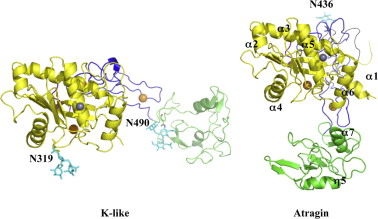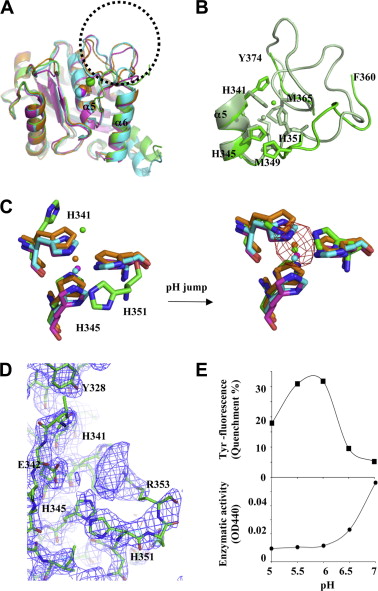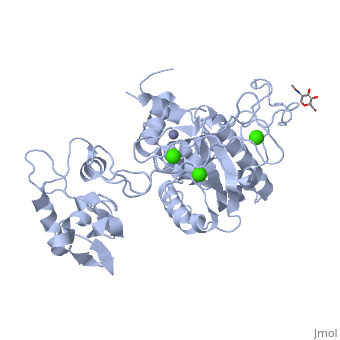Introduction
Atragin (MW 49.7 kDa and theoretical pI 8.6) is a Snake Venom MetalloProtease (SVMP) belonging to the ADAM/adamlysin/ reprolysin family and is found in the venom of the Naja Atra, or Chinese cobra [1]. It contains a metalloprotease domain (M),disintegrin-like domain(D), and cysteine-rich domain (C), making it a P-III SVMP [2]. When injected into the bloodstream, P-III SVMPs cause hemorrhagic effects, inhibit platelet formation and inhibit cell migration activity[1][3]. These P-III SVMPs bear very close resemblance to mammalian ADAM (A Disintegrin And Metalloprotease) proteins, which also contain the MDC domain architecture [4]. The ADAMs are a group of around 40 transmembrane proteins that have been found so far in mammals, 19 of which genes are found in humans [5][6]. These proteins play a role in the production of cytokines and growth factors, such as ADAM 17 which releases tumor necrosis factor alpha (TNFa) as an immunomodulatory and pro-inflammatory cytokine [7]; and ADAM 9 which has been shown to be involved in the release of heparin-binding EGF, which inhibits the proliferation of neighboring cells [8]. ADAM proteins have also been shown to be involved with multiple human diseases today, including cancer, asthma, cardiac hypertrophy and SARS [9][10][11][12]. Unfortunately, the full structure of the ADAM proteins is not yet available and our current understanding of the ADAM structure is based primarily on viper P-III SVMPs[4][13][14][14][15] . Atragin, however, is an elapid P-III SVMP and provides more clues as to how the MDC domains work together.
Structure
is a 63x52x67 Å protein that contains a Metalloprotease domain, Disintegrin-like domain, and a cysteine-rich domain[1]. The overall architecture of the protein gives a structure that is similar to other P-III SVMPs such as VAP1 [14] in that the recognition site of the C domain faces the M domain’s catalytic cleft in a linear orientation, which means the target recognized by the C domain could be the same as the substrate catalyzed by M domain. This is a contrast to other P-III SVMPs, such as the K-like protein shown below, which can have an I-shaped structure that contains a non-linear orientation between the C and M domains, in which the target recognized by the C domain can be different than the catalyzed substrate molecule [1].
 [1]
[1]
'Metalloprotease Domain
The Metalloprotease domain (M) consists of
and is a metalloendopeptidase. Every endometalloprotease contains a strain of residues needed for zinc and substrate binding for proteolysis. In Atragin, the binding sequence can be found from aa 341-351. The atom is ligated by the side chains of His341 and 345 on the a-helix, and this allows His 351 at the turn the be responsible for the catalytic reaction [16].
One of the ways that the N. atra is able to prevent self-proteolysis is by storing the atragrin protein in a venom lumen gland at an acidic pH and containing citrate and the tripeptide pyroglutamyl-lysyl-tryptophan enzymatic inhibitor in the gland[1][17][18]. In acidic conditions, there is no detectable electron density at the flexible loop, which contains the Met-turn. Under acidic conditions, the prononated histidines cause a structural change which results in an unfixed position of the zinc atom [1]. The picture below shows the general movement of the histidines.
 [1]
[1]
'Disintegrin-like Domain
Following the M domain and a linker , is the (D) domain. This domain is thought to play an important role in the relative orientation of the M and C domains in P-III SVMPs (Think back to C-shaped versus I-shaped). Atragin maintains the C-shaped architecture as its domain has three disulfide bonds, and its conatins another 3 disulfide bonds, which is similar to other C-shaped proteins [4][14]. These multiple disulfide bonds make the protein structure very stable. One also connects these two subdomains.
The disulfide bond pattern in the D domain alters the orientations of the in the ADAM/adamalysin/ reprolysins family [1]. The different orientations could explain some of the ADAM enzymatic processes, seeing as the different lengths or altering the disulfide pairs of the D-domain can increase or decrease the size of the cleft and the orientation. This could cause for substrates of different sizes and shapes to able to be cleaved by the M-domain in ADAMs [1].
'Cysteine-rich Domain
The Cysteine-rich (C) domain contains the domains. The C-hand subdomain is the most intriguing to most researches because it contains the Hyper Variable Region (HVR. This region is through to play an important role in target selection since it sits on the inside of the C-shaped structures cleft [14]. The C domain of Atragin consists of seven , and this suggests it may play a functional role. The HVR of Atragin is also though to be responsible for the inhibitory affect on cell migration activity since it is exposed to target recognition [1].



